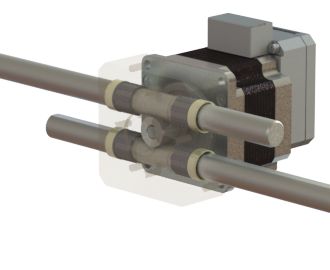Myostat
Stepping Up

Also known as Vector Drive, Field Oriented Control was the answer for one of our clients, an Ontario-based automated food sorting and grading company that needed a system for a very demanding application with a large inertia mismatch. Current feedback and the ability to stop on position, fifteen times per second, were critical to achieving their system requirements. The focus for this application was on a 2-phase, permanent magnet stepper, although the theory can, in general, be applied to all stepper variants.
A typical 2-phase stepper motor has fifty magnetic poles on the rotor. These poles lead to detent torque, or cogging, which cause undesirable effects on motion speed and positioning as the discrete step tends to snap the rotor from one position to another. Stepper motors provide high torque at low speeds; however, torque speed curves do show a significant decrease in torque at higher rotational speeds.
The more expensive AC synchronous motor has four or eight poles, produces a flat torque line that extends to high speeds and has little issue with vibration or resonance. By implementing Field Oriented Control, we can provide an affordable solution that provides both smooth motion at slow speeds and is efficient at high speeds.
A key aspect of Field Oriented Control is that, to maximise torque, every rotor position has an optimal magnitude and direction of the stator net magnetic field. FOC requires current feedback from both phase windings in the stepper as well as accurate position feedback of the rotor. With this data we can calculate the optimum magnetic field magnitude and direction for the given rotor position (see figure 1).
The application of FOC results in more accurate torque control, higher efficiency and the ability to control stator flux direction and magnitude independently. It also produces good transient and steady state control of the motor, all resulting in smooth and accurate motion. Although a current sensor is required, this is easily realized by placing a low resistance resistor in series with the motor phase winding. Reading the potential drop over the resistor indicates the winding current.
In order to achieve their strict requirements, our client had tested 48V motors but were unsatisfied with the result. By implementing Field Oriented Control, we were able to run at 24V, which was important for their machine certification requirements. They were also able to use a NEMA23 frame size motor, which was critical to their machine design in that they were limited to a very small space envelope.
While Field Oriented Control does add some costs to the motor, it will allow for a smaller motor, use less voltage and run cooler—saving time, space and energy.

This article originally appeared in the November/December 2011 Issue of Design Engineering.
Mark McCann, B.Sc. Eng., is the Lead Design Engineer and automation solutions provider at Myostat Motion Control. During his eight years with the company, Mark has worked on Cool Muscle integrated servos and robotics, hardware, electronic circuit design, software, micro controller firmware development and windows application programming.